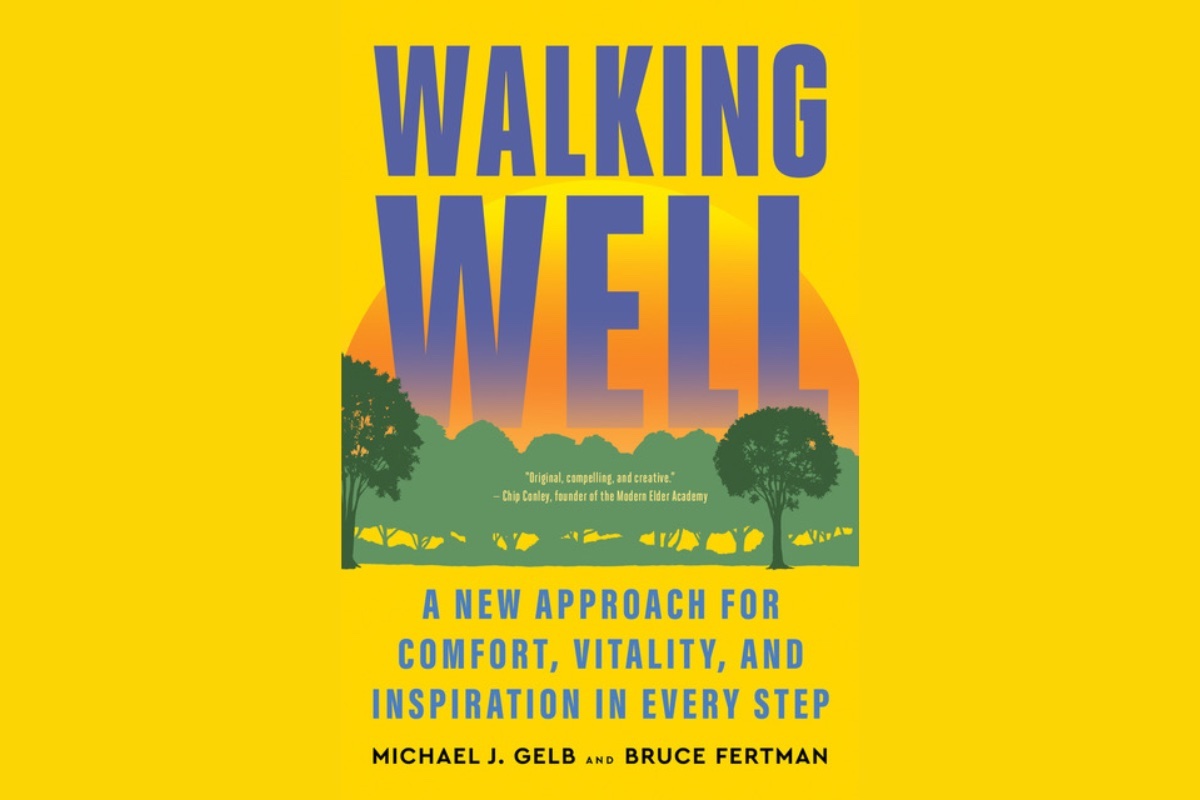
An excerpt from Walking Well, by Michael J. Gelb and Bruce Fertman
Isaac Newton, who formulated the theory of gravity, was a student at Cambridge when the Great Plague of 1665 ravaged London and then spread throughout the country. Newton chose to quarantine at Woolsthorpe Manor, his family estate, about sixty miles northwest of Cambridge. His daily walks in the beautiful countryside helped to inspire his annus mirabilis — the “wonderful year” during which he invented calculus and formulated his laws of motion.
Newton’s third law of motion states that “every action has an equal and opposite reaction.” When you paddle a canoe, for example, you press the paddle back into the water to propel the canoe forward. Every time you take a step, you apply a force to the ground, and the ground effectively applies an equal force to your foot, in the opposite direction, propelling you forward.
You don’t need a degree in physics to realize that as you peel-peel along you can allow the ground to massage your feet so that your feet and toes spread out more with every step. Many of our students find that they need to get wider shoes after practicing this new approach to walking.
Zen monk and author Thich Nhat Hanh advised, “Walk as if you are kissing the Earth with your feet.” Yes! And go one step further and realize that when your feet are kissing the Earth, the Earth is kissing you too. And it’s not just a little peck. It’s a big, juicy smooch!
Big bear feet
As your feet spread out on the ground, you will begin to experience that they are bigger than you might have thought. How big are they? Let’s find out.
Which is longer, your forearm or your foot? Most people think that their forearm is longer. If you remove one of your shoes and place the sole of your foot against your forearm, you’ll discover that they are the same length. How can we use this discovery to help us experience more comfort when we walk?
Begin by accepting that your feet are bigger than you thought. As you accept and appreciate just how big your feet are, you can allow them to spread out even more with every step. This isn’t something you need to try to do. The ground will do it for you. As you let your feet spread out, they will feel more comfortable, and they will thank you every day.
Unlike most other mammals — which walk on their toes — we humans use the whole length of our sole when we walk. Dogs and cats, for example, are digitigrades (digitus is Latin for “finger” or “toe” and gradior is Latin for “walk,”) whereas humans and bears are plantigrades (planta is Latin for “sole of the foot”). The skeletal structure of human feet and hands and bear paws is remarkably similar. In fact, at first glance, it is hard to tell them apart.
One reason our feet feel smaller than they are is that most of us, unlike bears and other plantigrades, hold a lot of unnecessary tension in our feet. We are so used to this tension that we become oblivious to it until we let go of it. Then it can be a revelation; as one of our students exclaimed, “Oh my God, I was tensing my feet up so much. I had no idea.”
Here’s an easy, pleasurable practice that will help you let go of all that foot tension you don’t need, allowing you to experience the true size of your feet. All you need is a tennis ball and about five minutes.
Remove your shoes and without straining, do a gentle forward bend, reaching your fingers down toward your toes. Notice how far down you can go comfortably.
Then, using the wall, a chair, or the kitchen counter for support, place the tennis ball directly underneath your right foot. Use the ball to massage your foot, rolling it along the sole, underneath the heel, and along the edges of your foot. Put as much weight on the ball as you can without causing too much pain. Do this for about two minutes.
Then, without straining, do another gentle forward bend, reaching toward your toes. Notice how far down you can go comfortably and if there’s any difference between the right and left side of your body. Most people are surprised to discover that after just two minutes they are more flexible on the whole right side of the body from this self-massage and that their right fingers now go further down than they did at first.
Now let’s do the left side. Again, support yourself using the wall, chair, or kitchen counter and place the ball directly underneath your left foot. Use the ball to massage your foot, rolling it along the sole, underneath the heel, and along the edges of your foot. Put as much weight on the ball as you can without causing too much pain. Do this for about two minutes.
Then explore another forward bend. Most people are delighted to discover that they are more flexible now, and that their feet feel much more expansive and relaxed. When practiced every day, this self-massage will help you walk with big, soft, supple, bearlike feet.
Big bear paws
Go for a walk after giving yourself the rolling foot massage, and enjoy the experience of letting your feet be as big as they truly are. As your big bear feet spread into the ground behind you, you’ll begin feeling your arms and hands swinging more freely. You don’t have to do anything with your upper body to get this swing going. Just let it happen. If your feet are bigger than you thought, maybe your hands are too?
You can confirm this by looking into a mirror and considering the distance between the bottom of your chin and the top of your head. Now look at your hands. Which is longer? Look in the mirror again, and this time place the end of your wrist at the bottom of your chin and extend your fingers as far as they go and see how close they get to the top of your head. Most people are surprised to discover that their hands are also bigger than they thought.
So pause and luxuriate in the feeling of your hands becoming big bear paws. You don’t have to use any effort to swing your hands as you walk; your big bear feet peel-peeling will swing your hands for you.
It helps to consider your wrists as integral parts of your hands. A wrist is not just a thin, horizontal line dividing your hand from your forearm. Each of your wrists is comprised of eight movable bones. Wrists are bigger, wider, longer, and thicker than we think. As you experience the mobility of those eight wrist bones, enjoying the fullness of your hands and wrists as you walk, you may discover that the stiffness and cramping caused by overuse of smartphones and other manual devices begins to ease with every swing of your paws. As you walk, imagine that your huge bear paws have never held an electronic device, never typed, never texted or held a pencil or pen. What a relief!
Experiment with saying paw-paw with each swing of your hands. We say “swing of your hands” rather than “arm swing” because if you think about swinging your arms, you will likely use too much force. Rather than swinging your arms, allow them to be swung. If you think about your bear feet peel-peeling and you sense your big bear paws with loose wrists, then your big bear paws and your loose wrists will swing your arms for you.
Play now with combining peel-peel and paw-paw. As you walk, experiment with saying, to yourself or out loud, “Peel-peel, paw-paw, peel-peel, paw-paw” until you can sense your feet and hands moving together in a natural alternating rhythmic pattern with every step.
Excerpted from the book Walking Well: A New Approach for Comfort, Vitality, and Inspiration in Every Step. Copyright© 2024 by Michael J. Gelb and Bruce Fertman. Reprinted with permission from New World Library. www.newworldlibrary.com
We’d love to hear from you! Please send us your suggestions for future articles. And if you’re a writer, please see our writer’s submissions page for details.


